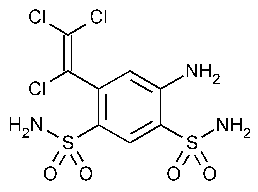Clorsulon
»Clorsulon contains not less than 98.0percent and not more than 101.0percent of C8H8Cl3N3O4S2,calculated on the dried basis.
Packaging and storage—
Preserve in well-closed containers.
Labeling—
Label it to indicate that it is for veterinary use only.
Identification—
A:
Infrared Absorption á197Mñ.
B:
The chromatogram of theAssay preparation obtained as directed in theAssayexhibits a major peak for clorsulon,the retention time of which corresponds to that of theStandard preparationobtained as directed in the Assay.
Loss on drying á731ñ—
Dry it in vacuum at 100 for 4hours:it loses not more than 0.5%of its weight.
for 4hours:it loses not more than 0.5%of its weight.
Residue on ignition á281ñ:
not more than 0.1%.
Heavy metals,Method IIá231ñ:
0.003%.
Chromatographic purity—
[NOTE—The Standard solutions andTest solutions should be stored in low-actinic glassware.]Prepare a solution of Clorsulon in methanol containing 10.0mg per mL(Test solution).Prepare a solution of USP Clorsulon RSin methanol containing 10.0mg per mL(Standard solution A).Transfer 1.0mLofStandard solution Ato a 100-mLvolumetric flask,dilute with methanol to volume,and mix (Standard solution B).Apply 10-µLportions of theTest solution and of Standard solution A,and 5-and 10-µLportions ofStandard solution Bto a suitable thin-layer chromatographic plate (see Chromatography á621ñ),coated with a 0.25-mm layer of chromatographic silica gel mixture.Allow the spots to dry,and develop the chromatograms in a solvent system consisting of a mixture of chloroform and methanol (4:1)until the solvent front has moved about three-fourths of the length of the plate.Remove the plate from the developing chamber,mark the solvent front,allow the solvent to evaporate,and examine the plate under short-wavelength UVlight:the chromatograms show principal spots at about the sameRFvalue.Estimate the amounts of any additional spots observed in the chromatogram of theTest solution by comparing them with the spots in the two chromatograms obtained fromStandard solution B,corresponding to 0.5%and 1.0%of impurity:no spot,other than the principal spot,in the chromatogram of theTest solutionis larger or more intense than that of the principal spot in the chromatogram obtained from the 5-µLportion of Standard solution B(0.5%),and the sum of all such impurities is not more than 2.0%.
Assay—
Mobile phase—
Prepare a filtered and degassed mixture of water,acetonitrile,and glacial acetic acid (70:30:0.1).Make adjustments if necessary (seeSystem SuitabilityunderChromatography á621ñ).
Standard preparation—
Dissolve an accurately weighed quantity of USP Clorsulon RSinMobile phase to obtain a solution having a known concentration of about 0.1mg per mL.Store the solution in low-actinic glassware.
Assay preparation—
Transfer about 50mg of Clorsulon,accurately weighed,to a 50-mLvolumetric flask,dilute withMobile phase to volume,and mix.Transfer 5.0mLof this solution to a second 50-mLvolumetric flask,dilute withMobile phase to volume,and mix.Store the solution in low-actinic glassware.
Chromatographic system(see Chromatography á621ñ)—
The liquid chromatograph is equipped with a 254-nm detector and a 4.6-mm ×25-cm column that contains packing L7.The flow rate is about 1mLper minute.Chromatograph theStandard preparation,and record the peak responses as directed forProcedure:the column efficiency is not less than 7400theoretical plates;the tailing factor is not more than 1.4;and the relative standard deviation for replicate injections is not more than 1.0%.
Procedure—
Separately inject equal volumes (about 30µL)of theStandard preparation and theAssay preparation into the chromatograph,record the chromatograms,and measure the responses for the major peaks.Calculate the quantity,in mg,of C8H8Cl3N3O4S2in the portion of Clorsulon taken by the formula:
500C(rU/rS),
in whichCis the concentration,in mg per mL,of USP Clorsulon RSin theStandard preparation;and rUandrSare the clorsulon peak responses obtained from theAssay preparation and theStandard preparation,respectively.
Auxiliary Information—
Staff Liaison:Ian DeVeau,Ph.D.,Senior Scientist
Expert Committee:(VET)Veterinary Drugs
USP28–NF23Page 519
Pharmacopeial Forum:Volume No.28(2)Page 269
Phone Number:1-301-816-8178
